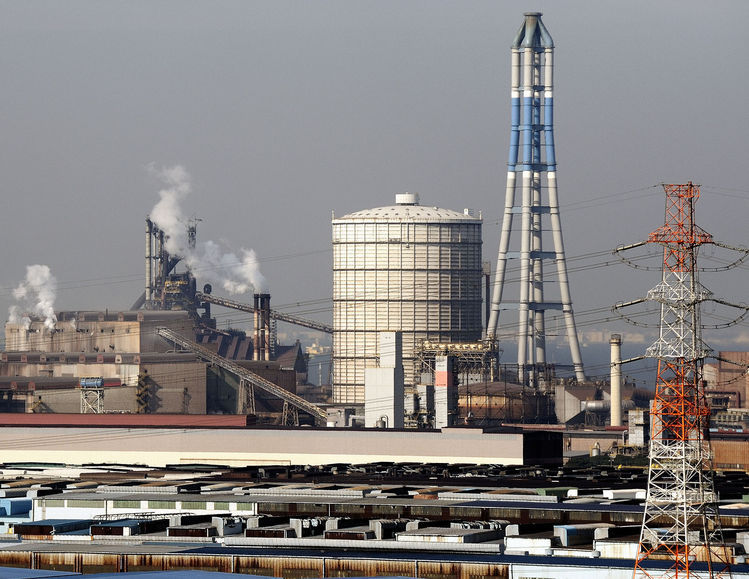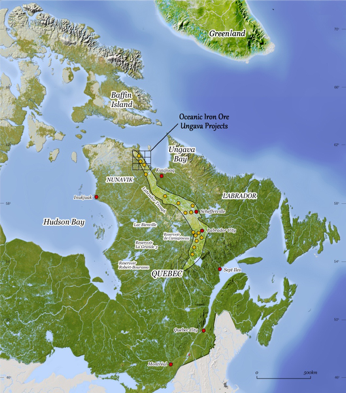
Nippon Steel Corp.'s Kimitsu Works in Kimitsu City, Chiba Prefecture, Japan. Robert Gilhooly/Bloomberg
Editorial by Alan Gorman
President CEO Oceanic Iron Ore Corp
April 22, 2015
All iron ore is not created equal. While the Australian iron ore market has clear and distinct advantages in respect of ocean freight costs, and the existing major producers are once again consolidating a near monopoly on supply within the seaborne market, there is another key variable in the global marketplace that the recent cycle has largely overlooked.
Quality of iron ore, globally, has been in a steady state of decline for the past decade as China's urbanization has produced an insatiable demand for the commodity. The current analysis of the iron ore market largely overlooks the impact of declining quality when projecting future prices, specifically the increasing supply of high silica, high phosphorous, and high alumina iron ores on steel quality and blast furnace performance.
Japan has concentrated its production on high quality steel products, and producers in this segment of the steel market presently cite current sources of supply as problematic from a quality perspective. While the majors will continue to meet the base needs of steel producers well into the future those same steel producers will have an increasing appetite for high quality iron ore supply sources either as primary sources of feed or to blend with declining quality ores from Australia and Brazil.
Enter Canada
Canadian iron ores are consistently high quality products and that attribute is acknowledged by Japanese steel producers. This distinction will gain growing prominence by Chinese steel producers, as well as others, going forward. During the past decade much of China's steel production has been geared to long steel products produced for construction of infrastructure. As China's export economy transitions to one that is consumption based, the demand for flat steel will increase and the quality paradox facing Japanese steel producers today will be amplified as the demand for high quality flat steel increases. In order to distinguish steel production, infrastructure requires long steel products such as columns, beams, and rebar, capable of tolerating lower quality iron ore and resulting in lower quality steel in the production process. Flat steel demands higher quality iron ore feed and results in a higher quality steel product suitable for the production of automobiles and other consumer goods.
In the near future (I expect no more than five to ten years), the price differentiation between iron ores suitable for long steel and iron ore supplied for flat steel production should see a marked gap in their selling prices with the highest quality ores attracting the best premiums. This differentiation in sell pricing existed in the iron ore sector before China emerged as the global leader in steel supply and consumption and it will be reinstated moving forward. It may be no accident that Chinese investment in Canada's Labrador trough over the past decade has involved the acquisition of resources with no particular expediency on seeing them developed. WISCO and Hebei have literally locked up billions of tonnes of high quality Canadian iron ore resources over the past 10 years. Have they been strategic from a quality perspective in marking these investments?
While China is content to have the world believe that it's demand has all but dried up, the creation of the Asian Infrastructure Investment Bank (AIIB) and its 21st century Belt and Road development plan would suggest that China is gearing up to export long steel products. From a trade perspective the country needs the exports, and from a capacity point of view its substantial manufacturing capability is a guaranteed source of export revenue in the global marketplace where it appears ready to create both the demand for its steel via the Silk Road and the mechanisms to finance it via the AIIB. Some are forecasting the recently announced Belt and Road infrastructure initiative as a $31 trillion investment focused on establishing an updated and effective transportation network that spans Asia, Europe, northern Africa and the Middle East.
Absent initiatives such as these China would see continuing declines in GDP growth, increased unemployment, and a growing trade imbalance that would impede the country's future fortunes as it loses competitiveness in other sectors, such as electronics and textiles, produced for export, as inflationary pressures continue to take hold.
Steel produced for export in China thus far has been less significant. During 2014 steel was China's #10 export and represented 2.6% of the country's exports by value among exports totalling $2.3 trillion. Only about 10% of the country's steel was made available for export. So while China is retooling some of its plants to produce greater volumes of flat products to satisfy its own growing consumption needs and undoubtedly a strategy to grow exports in the automotive and white goods sectors, it clearly intends to export long steel products to support an infrastructure vision that is every bit as ambitious as its own recent domestic modernization.
While yesterday's outlook in the iron ore and commodities markets for Canadian producers and developers looked anemic, the tides will change for Canadian iron ore as well as other nonferrous commodities. As some analysts argue whether the current state of the market represents structural or cyclical change the fact that quality continues to decline is definitively structural and future pricing structures will reflect that. Current oversupply in respect of volumes may be either structural (though the argument is not compelling given high cost Chinese domestic production is still responsible, in large part, for the current global surplus) or cyclical. In either case Canadian iron ore will gain much greater prominence in the supply chain.
Alan Gorman is a Montreal, Quebec based mining entrepreneur and President and CEO of Oceanic Iron Ore Corp (FEO.TSXV), which is developing the Hopes Advance iron ore project in Quebec’s Labrador Trough. For more information, visit www.OceanicIronOre.com and see the company’s profile on www.SEDAR.com.






















